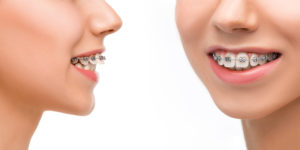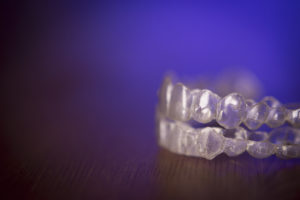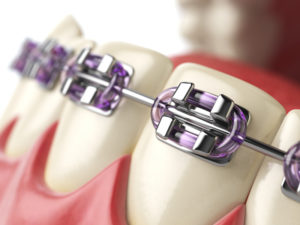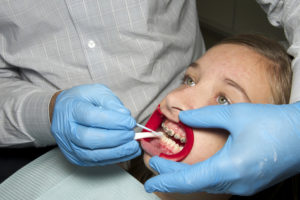How To Fix A Misaligned Jaw

Many orthodontic patients suffer from a misaligned jaw that affects how teeth sit in the mouth and causes bite problems. Overbites, where the upper teeth protrude, and underbites, when the lower teeth sit out farther than the upper teeth, can cause physical and emotional discomfort. If left untreated, a misaligned jaw can affect how you eat, speak and sleep. Luckily, there are many types of orthodontic treatments and appliances that are used to correct misalignments and give you your confidence back. Find out what to do if you have a misaligned jaw with this guide!
What A Misaligned Jaw Looks Like
Many people receive orthodontic treatment to fix their crooked teeth, but braces can also resolve bite issues, as well. Braces are great ways to fix misaligned jaws in children and adults and help prevent the consequences of underbites and overbites. Misaligned jaws are often painful and obvious, and many children are unfortunately teased by their peers because of it. Our “bite” refers to how the upper and lower teeth meet together, which influences how we chew, eat and speak. The two most common bite problems are an underbite and overbite, with an underbite occurring whenever the lower jaw sits in front of the upper jaw while the overbite happens when the upper jaw protrudes abnormally over the lower jaw. While these deformities look awkward, they have consequences that are more serious than aesthetic concerns. Underbite create a bulldog appearance as the lower jaw protrudes out, which not only puts a lot of stress on the joints but also causes tooth wear. Overbites create buck teeth that stick out so far that they can easily break and make it difficult to close the mouth and lips. They also create an elongated face, speech problems and increase the likelihood of tooth decay as oral tissue dries out. Depending on the severity of the misalignment and which bite is involved, treatment options such as braces, cosmetic dentistry and surgery are common ways to fix the problem.
Treatment Options
For crooked or crowded teeth and misaligned jaws, braces are the standard treatment performed for most patients. Traditional braces with brackets cemented to the teeth and attached with an archwire help with overbites to straighten the upper front teeth and bring them into a non-protruded position. For extreme cases of overbites and underbites, headwear braces may be necessary. These devices are made with internal and external wires, along with straps that fit over the head and neck, to move the upper jaw either forward or backward. Headwear braces are typically worn for 12-14 hours a day, but are only needed whenever traditional braces cannot fix misalignment. For underbites, an upper jaw expander is recommended to widen the palate of the mouth so that the lower teeth move back into position. The expander is placed in the upper palate of the mouth and widened each night with a special key, and after one year, the palate should be wide enough for both the upper and lower jaws to fit together. For the most serious cases of jaw misalignment, orthognathic jaw surgery will be required. Plates, screws and wires will be surgically placed into the jaw by a maxillofacial surgeon to permanently correct bite problems, which will greatly improve speech and sleep.
Importance of Orthodontic Visits
While many bite problems are obvious, some are so slight that detection will be hard to notice. In these cases, it’s important that children and adults have regular orthodontic visits so that teeth movement and development can be monitored. Orthodontic visits, especially in young children, are essential to observe incoming teeth, reduce the risk of impacted teeth, monitor jaw development and detect hidden dental issues. Not only will your teeth be examined, but your jaws and mouth will be reviewed for signs of underlying conditions, decay and disease, as well as thoroughly cleaned. These visits also provide patients the information they need to establish good dental habits early on to keep their teeth healthy and free from decay both during and after orthodontic treatment.
Get Straighter Teeth With Our Help!
At Belmar Orthodontics, we specialize in helping children and adults alike fix malocclusion, adjust misaligned jaws and get the smiles that they deserve. Whether you or your child has an underbite, overbite or crowded teeth, our team can help you remedy any issue that you are experiencing. Through specialized orthodontic treatment plans and advanced appliances, your mouth issues can be fixed within a short period of time. Call our office today at (303) 225-9016 to get a straighter smile today!
Does Your Child Really Need Braces?

We typically get our braces put on during our teenage to adult years, but how do you know whether your young child should have braces or not? Child orthodontics is a common practice for those children struggling with crooked, overlapping, or overcrowded teeth, or a misaligned jaw. There are many advantages for children as they receive braces earlier on in life as it can prevent future orthodontic treatment and guide incoming teeth into the proper position. Learn how to recognize whether your child needs braces through these tips!
When To Start
Young kids go through a lot of physical changes during adolescence, and some of those changes include jaw and teeth development. Orthodontics has become more and more common in young children to adjust certain orthodontic issues that occasionally occur as a child develops. Traditionally, orthodontic treatment begins once a child has lost most of their baby (primary) teeth and a majority of their permanent teeth have grown in, which typically occurs between the ages of 8 and 14. Even though braces is recommended at this age, it is a good idea to get an orthodontic evaluation for your child by the time they turn 7 years old; at this age, an orthodontist is able to detect early symptoms of orthodontic problems, such as an underbite or crossbite, which can cause severe complications and more treatment later on if left untreated at an early age. Bones are still growing during this age, so it is an ideal time to meet with an orthodontist to monitor bone and jaw development while evaluating any apparent orthodontic issues.
Advantages of Child Orthodontics
Although child orthodontics is only necessary if there are physical developmental issues within the mouth, receiving orthodontic treatment as a child has certain advantages. Visiting an orthodontist at an early age allows for observation of incoming teeth and reduces the risk of impacted teeth as your child loses their baby teeth and their permanent teeth take their place. As the orthodontist monitors your child’s teeth, they can help guide their teeth into the correct position as soon as they begin erupting, usually through braces or other orthodontic devices that help move teeth into the correct positions. Regular orthodontic visits also decrease the risk of hidden dental issues and permanent tooth extractions, as it allows for the orthodontist to adjust the jaw so that teeth crowding doesn’t occur.
Child orthodontics doesn’t always imply braces. Since a child’s jaw and teeth are still growing, many orthodontic issues, such as crowding, can be addressed before complications occur later on during adolescence. In this case, orthodontic treatment in young children is known as interceptive orthodontics. Many times, a child’s dental arch may be too small to fit all of their teeth. Just a few decades ago, it was a common practice to simply remove some permanent teeth to make space in the mouth. Now, though, child orthodontics can avoid this through the use of a palatal expander that expands the child’s upper dental arch, which allows adult teeth to emerge in a better position. Interceptive orthodontics can speed up the process of aligning teeth into the proper position and cause future treatment to be shorter and less involved.
How Much Does It Cost
If braces are fit too early on a child, treatment can take longer and be more expensive. For this reason, it’s important to have regular orthodontic visits to monitor tooth and jaw development to ensure that whenever your child receives braces, it’s at the correct time. The braces that your orthodontist recommends will depend on your child’s type of problem that he or she has. There are three types of braces that most children will receive, and they each have different advantages and disadvantages:
- Traditional metal braces – Have steel ties holding the wires between the brackets in place. Cost is driven by what your orthodontist will charge for treatment, including multiple office visits.
- Damon braces – Do not have steel ties, but the brackets themselves hold the wires in place. Typically more expensive and can cost up to $8,000, but you pay for less dental appointments since the braces are self-ligating.
- Invisalign (or other clear or removable aligners) – Fit over the child’s teeth similar to a mouthguard. Your child will receive a number of aligners during the duration of their treatment, so cost is determined by the amount of aligners needed to achieve correction.
Just like adult orthodontics, child orthodontics can cost anywhere between $3,000 and $8,000, depending on what level of correction your child needs. If your child needs to have teeth extracted or be fitted for other appliances, the cost will most likely go up, as well. The way your child complies to orthodontic treatment will also affect the cost. Make sure that they are brushing and flossing everyday so as to avoid tooth decay, which will increase the cost of treatment as your dentist will have to treat around the braces to fix the decay.
Is It Necessary?
As mentioned before, whether your child needs braces or not at an earlier age is dependent upon their mouth structure and how their teeth form. For more information about child orthodontics or if you’re interested in scheduling a consultation, contact Belmar Orthodontics at (303) 225-9016!. Our experienced and highly trained orthodontic staff offers a variety of orthodontic treatments and technology so that you can be confident your children are receiving the best care available.
What Is an Orthodontist?

If you want to be an orthodontist, you have at least 10-12 years of schooling ahead of you. Orthodontists are very similar to dentists, but they perform completely different tasks in an office than a dentist would do. This is why you need to see both an orthodontist and a dentist if you have braces. See what services they provide that no one else can!
Want to Become an Orthodontist?
To become an orthodontist, a person has to commit to at least 10-12 years of education, training, fellowships and more. Even after that time, and orthodontist must continue testing and studying throughout the years in order to do orthodontics. An orthodontist is a professional that specializes in correcting crooked smiles, bite and alignment issues, jaw problems and aesthetics of the mouth.
They do this through braces, which commonly consist of metal bracket and wire appliances. Those appliances mold the teeth and jaws into specific alignments and positions. Through focused pressure with these mouth appliances, a person with major bite, alignment, or crooked teeth problems can find themselves with a beautiful, functional smile. This is especially beneficial for patients who have oral health problems that cause them speech impediments and difficulty biting, chewing, speaking and functioning normally.

What Does An Orthodontist Do?
An orthodontist is a step above a dentist when it comes to their schooling. To become an orthodontist, a person must complete 4 years of undergraduate schooling at a university. They then apply for dental school and must be accepted. After 4 years of dental school, many students become dentists. However, orthodontists must continue to do at least 2 more years of orthodontic school and fellowships to do orthodontia as a profession.
Even though orthodontists are trained in dentistry, they do different work than dentists. They provide services such as correcting misaligned teeth and smiles, overbite, underbite, crossbite, and other alignment issues. Some are trained to provide surgical orthodontic procedures, or they work closely with an oral surgeon in correcting a misaligned jaw.
For patients who receive surgical orthodontics, an orthodontist will provide pre-surgical orthodontic care to align teeth and jaws as much as possible. A patient will then have oral surgery done to correct issues that can’t be done without surgery. Then, the jaws and teeth are aligned to their final, complete position through orthodontic appliances. If a patient doesn’t receive surgical orthodontics, they generally do 18-24 months of braces to straighten their teeth. Primarily, this is what an orthodontist does: they design braces (based on what type you pick) that fit your smile and that can shape it straight over the course of 1-2 years.
How It’s Different Than Dentistry
Both dentistry and orthodontics focus on oral health and improving a person’s smile. However, dentistry primarily strives to clean the teeth, fix tooth decay, perform root canals and treat gum disease. Patients also receive dental crowns, bridges and implants, and many cosmetic dentistry procedures. If you need teeth whitening or want to improve the look or health of your teeth, seek out a dentist. They can perform teeth whitening services, provide dental veneers and implants, and can help with oral health diseases.
However, if you need your teeth straight in the first place, you need an orthodontist. The American Dental Association recommends that every patient see a dentist at least twice a year to avoid major oral health diseases. You will need an orthodontist at various intervals in your life. However, you don’t see them as frequently throughout life like you would a dentist. When you have crooked teeth or problems with your jaws or alignment, you work with an orthodontist to fix the major issues. Then, a dentist fixes the more minor issues like the color of your teeth.
A dentist is not trained to straighten the teeth even if a dental office provides a transparent aligner service such as Invisalign. You always want to choose a trained orthodontist for properly straightening your teeth so oral issues don’t arise.

Do You Need Orthodontics?
When battling tooth decay, gum disease, bad breath and more, seek out a dentist. If you want to correct jaw, teeth, alignment, and bite issues, seek out an orthodontist. You may find yourself visiting both often if you receive braces as a child and then later as an adult or teen. Most orthodontists are trained to correct jaw and bite problems in children. You should always take your child in to see an orthodontist by age 7 if you already haven’t. The American Association of Orthodontics recommends this, as major bite and alignment issues of the jaws and teeth can be corrected easily when young. As a person grows older, the jaw hardens and becomes more permanently fixed, and oral health problems are much harder to correct.
If you are deciding to invest in braces, take a look at your teeth. Are they crooked? Do you find that either the upper or lower jaw overlaps the other significantly? Do you have problems speaking, eating, biting or chewing at times? You could benefit from orthodontics! Most people can significantly improve their oral health and their happiness (from having a beautiful smile) if they choose to see an orthodontist for help with their smile.
Dr. Hardy’s Office
Dr. Hardy is an award-winning orthodontist in Lakewood, CO. He is an active member of the American Dental Association and the American Association of Orthodontics. Dr. Hardy works with a team every day to make sure his patients young and old are cared for. At his center, he offers patients the option of getting ceramic, clear braces, traditional metal braces, lingual braces and Invisalign treatment. He can perform surgical orthodontics if needed and pediatric orthodontics. When choosing a center for your family, you want one that can treat patients of all ages and a center whose staff knows how to work really well with children. You can find that at Dr. Hardy’s Belmar Orthodontics office by calling (303) 225-9016!

